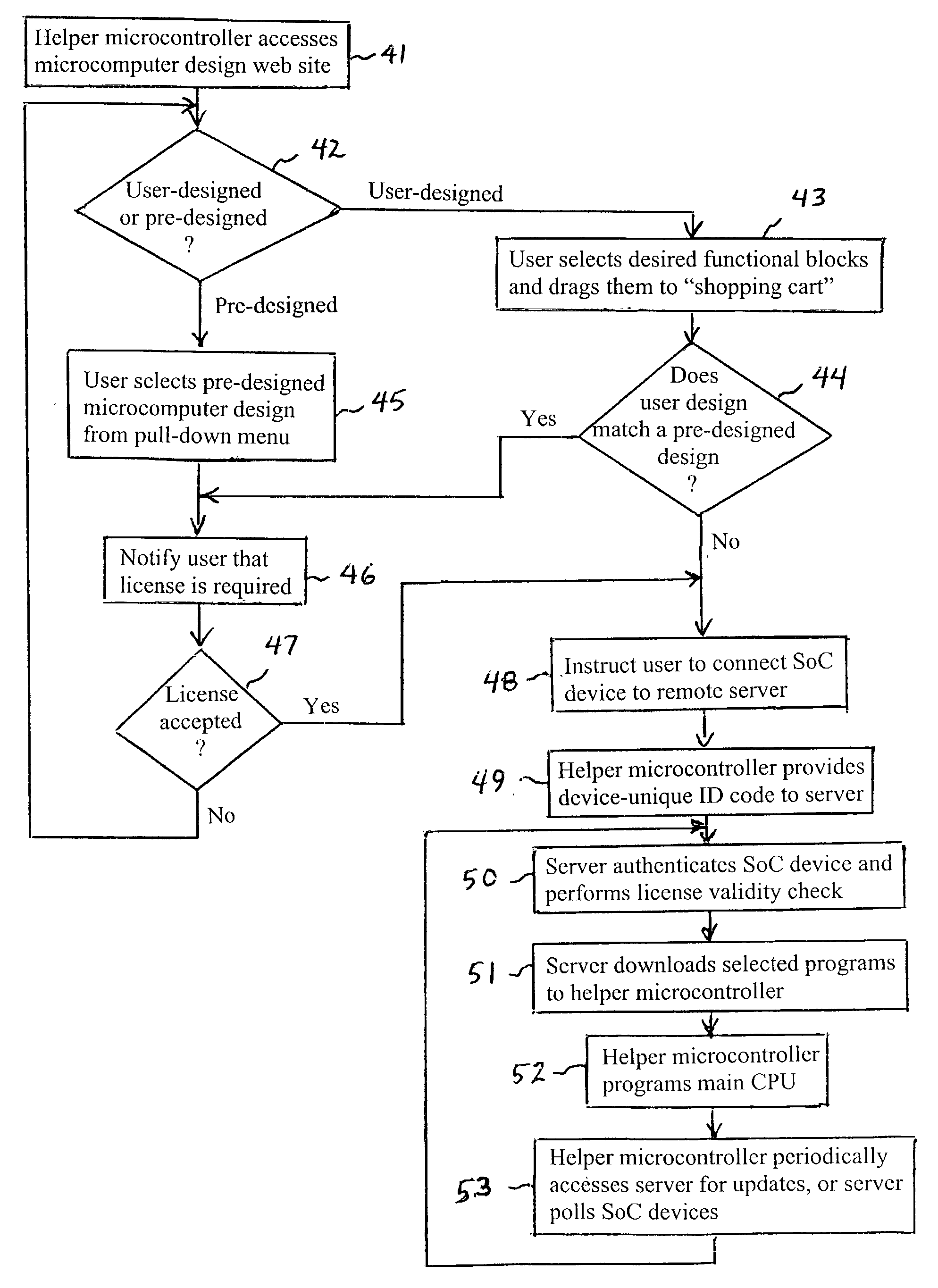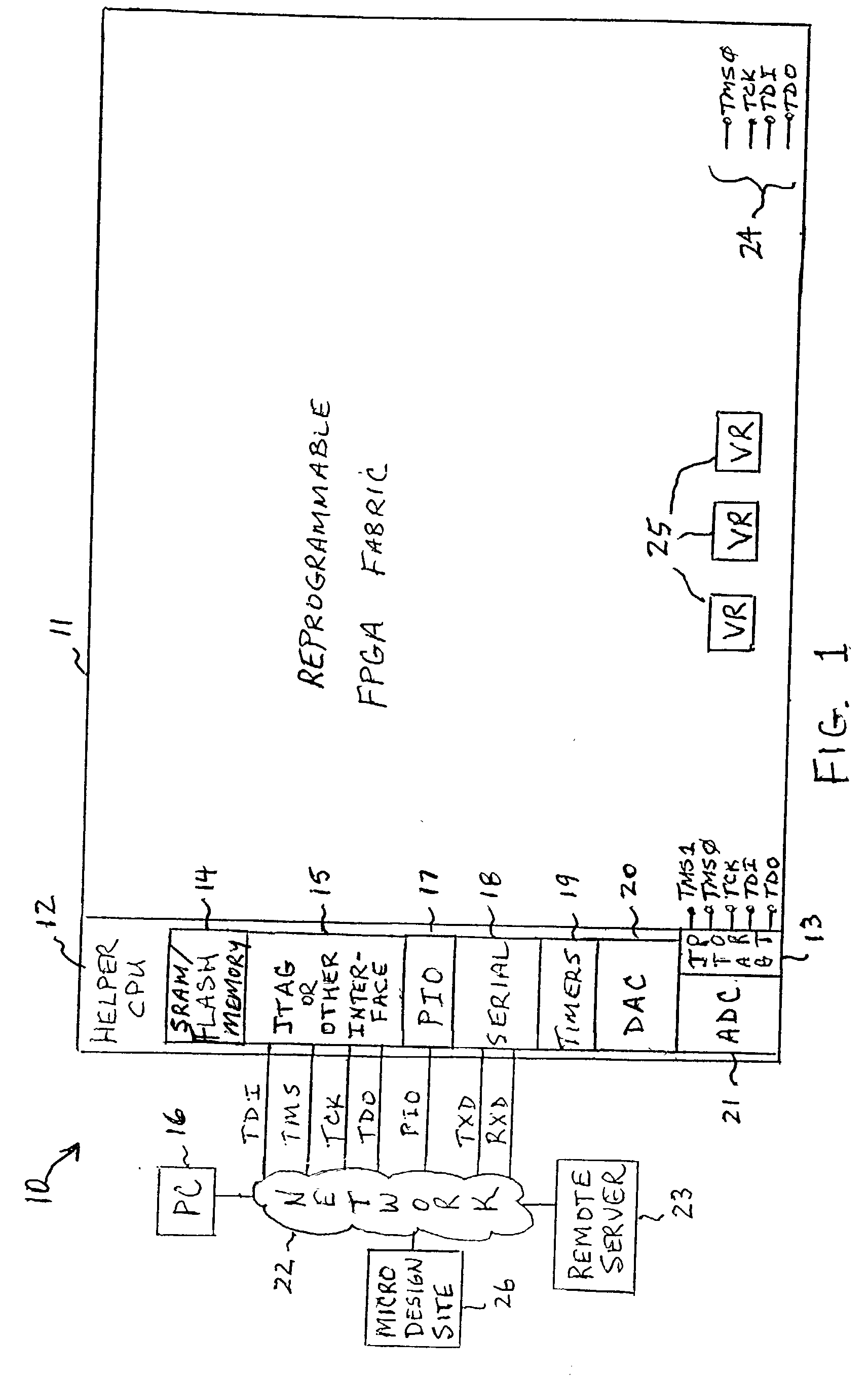Self-programmable microcomputer and method of remotely programming same
a microcomputer and self-programming technology, applied in the direction of cad circuit design, digital transmission, instruments, etc., can solve the problems of removing parts from the user's circuit, affecting the performance of the microcomputer, and affecting the user's experience,
- Summary
- Abstract
- Description
- Claims
- Application Information
AI Technical Summary
Problems solved by technology
Method used
Image
Examples
first embodiment
[0024] FIG. 1 is a simplified block diagram of the microcomputer 10 of the present invention. The microcomputer includes one or more FPGA fabric domains 11 for implementing one or more main CPUs. A "helper" microcontroller / programmer 12 is connected to the FPGA fabric through an IEEE 1149.1 JTAG port 13. The FPGA fabric has programmable logic cells and may additionally have hard macros such as multipliers, counters, serial ports / shifters, adders, and the like embedded therein. The FPGA fabric may also include one or more hard microcontroller CPUs and / or an array of microcontroller CPUs, and may include embedded RAM blocks which can be used by the downloaded main CPU as program / data memory.
[0025] The helper microcontroller may be any type of microcontroller (9-bit for example), and may be implemented on the same chip with the FPGA fabric, or may be implemented separately. The helper microcontroller's software / firmware may be reprogrammable. The helper microcontroller includes a memor...
second embodiment
[0030] FIG. 2 is a simplified block diagram of the microcomputer of the present invention in which the FPGA fabric is divided into a plurality of independent domains 11a-11n. A different main CPU may be programmed into each FPGA domain, and may utilize the same set of I / O pins. Each FPGA domain also includes virtual JTAG RTM tie-on points 24a-24n, enabling all of the multiple main CPUs to be debugged and monitored in real-time by way of the helper microcontroller and the RTM architecture. In FIG. 2, the FPGA fabric is shown as being anti-fuse fabric although in practice, the FPGA fabric may be anti-fuse or reprogrammable logic elements. When utilizing anti-fuse fabric, the user would ordinarily not be able to reprogram an FPGA device, or correct a programming mistake. With the present invention, however, after the first domain 11a is programmed, if the developer determines that there are mistakes in the design implementation or programming, or if an updated version of the design is ...
third embodiment
[0033] FIG. 3 is a simplified block diagram of the microcomputer of the present invention in which the components of the microcomputer are implemented separately. The helper microcontroller 12 may be utilized for programming and real-time debugging and monitoring of the main CPU 11, and can perform IEEE 1149.1 JTAG boundary scan (SAMPLE / PRELOAD) snap shots of the FPGA pins while the CPU is running. As with other embodiments, the microcomputer also provides a built-in, JTAG-accessible, real-time debug and monitoring interface in the helper microcontroller. Once programmed with the desired SoC design, the CPU can be debugged remotely in real-time through the helper microcontroller by one or more users.
[0034] The helper microcontroller 12 is illustrated as using a Standard Test and Programming Language (STAPL) file to program the main CPU 11. The serial RS232-compatible interface 18 is shown as the primary interface for providing this file to the helper microcontroller. Normally, the P...
PUM
 Login to View More
Login to View More Abstract
Description
Claims
Application Information
 Login to View More
Login to View More - R&D
- Intellectual Property
- Life Sciences
- Materials
- Tech Scout
- Unparalleled Data Quality
- Higher Quality Content
- 60% Fewer Hallucinations
Browse by: Latest US Patents, China's latest patents, Technical Efficacy Thesaurus, Application Domain, Technology Topic, Popular Technical Reports.
© 2025 PatSnap. All rights reserved.Legal|Privacy policy|Modern Slavery Act Transparency Statement|Sitemap|About US| Contact US: help@patsnap.com



